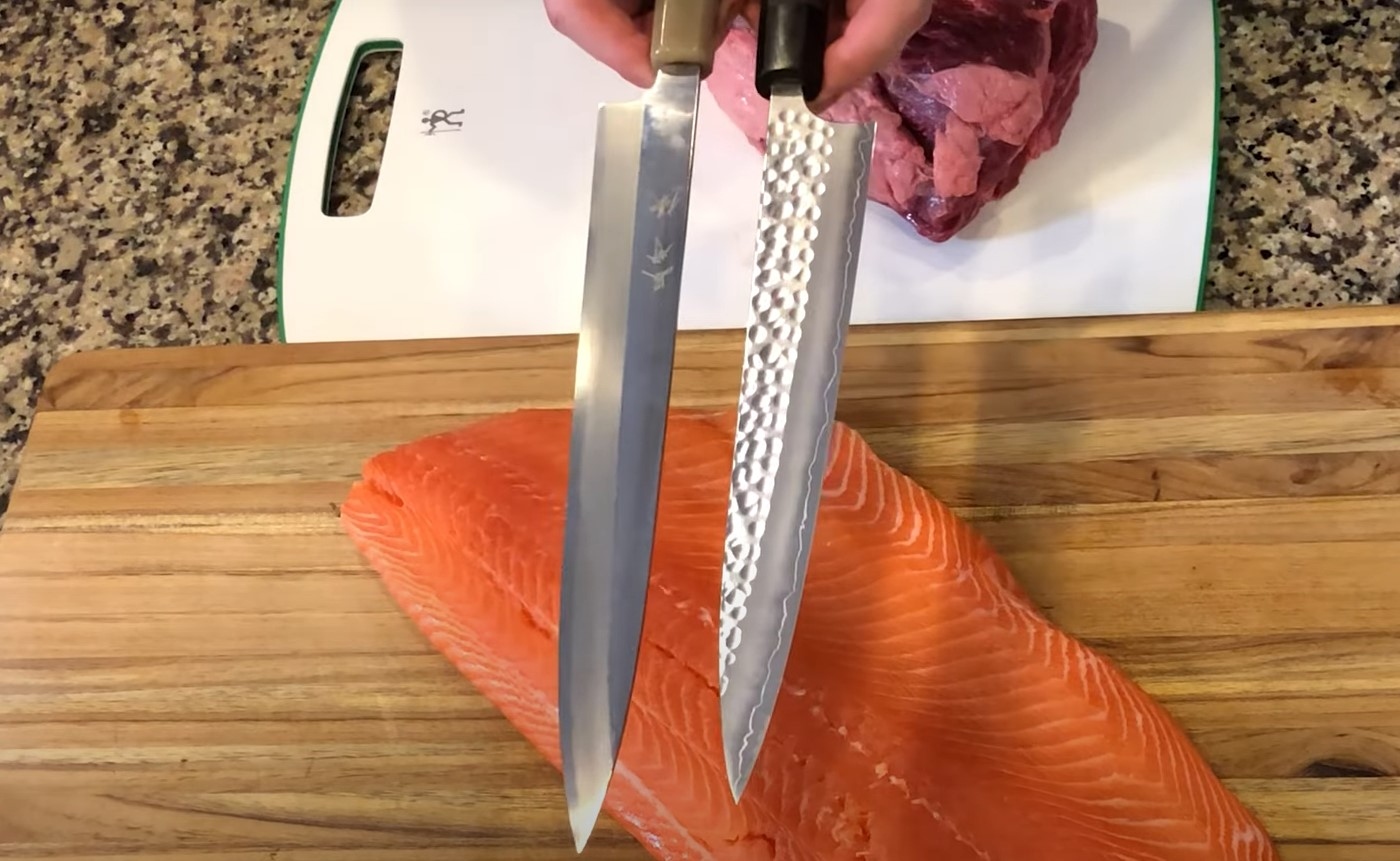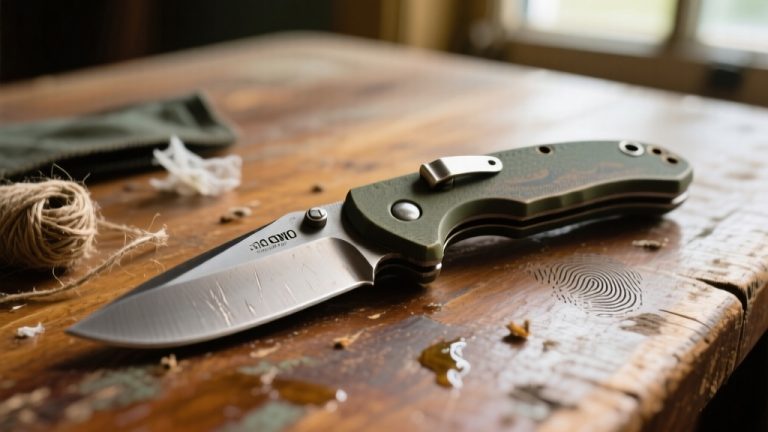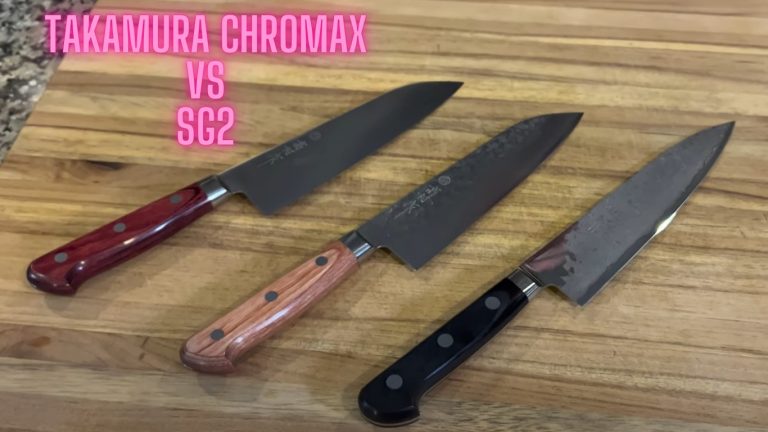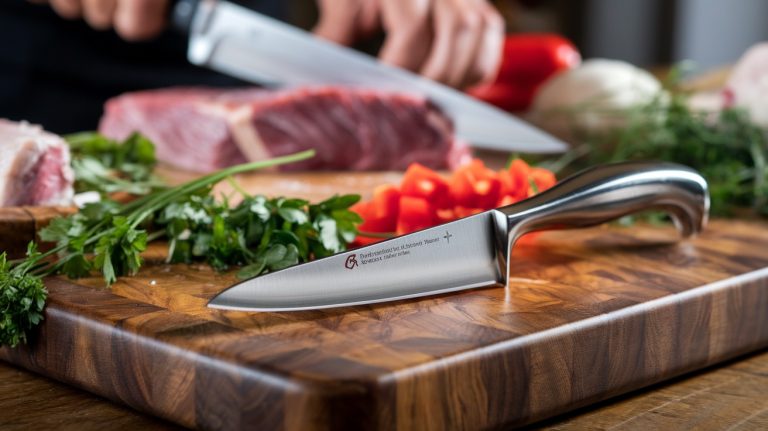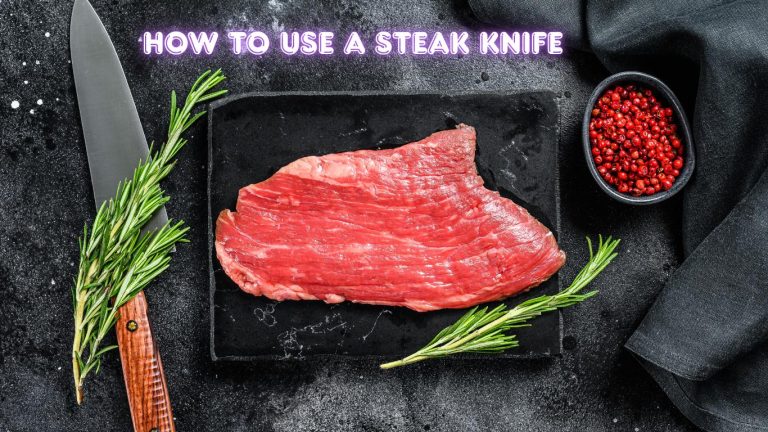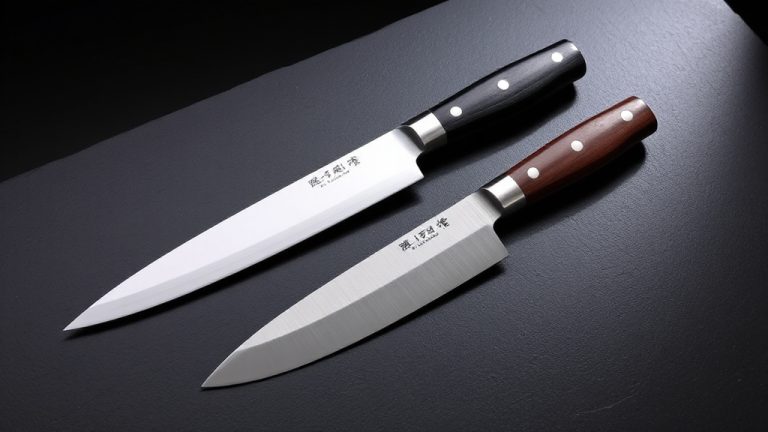Yanagiba Vs Sujihiki: Which Slicing Blade Belongs in Your Kitchen?
When choosing between a Yanagiba and a Sujihiki, you’re picking between specialized Japanese knives for precision slicing.
The Yanagiba, with its single-bevel edge, excels at crafting ultra-thin sashimi cuts, ideal for sushi mastery. The Sujihiki, with a double-bevel edge, offers versatility for slicing boneless meat and fish, making it beginner-friendly.
Both demand skill, but they cater to different tasks. Stick around to uncover deeper insights into their unique strengths and uses.
Key Takeaways
- Yanagiba is designed for slicing raw fish like sashimi, while Sujihiki excels at carving boneless meat.
- Yanagiba has a single-bevel edge for precision, whereas Sujihiki features a double-bevel edge for versatility.
- Yanagiba suits right-handed users and delicate cuts; Sujihiki is beginner-friendly for varied tasks.
- Yanagiba needs sharpening every 2-3 months; Sujihiki requires it every 4-6 weeks.
- Both knives cost $150-$200, but Yanagiba’s sharpening is trickier than Sujihiki’s.
Yanagiba and Sujihiki Overview
Precision is the name of the game when it comes to Japanese knives like the Yanagiba and Sujihiki, two blades that embody the art of slicing with unmatched finesse.
You’ll find the Yanagiba, meaning “willow leaf blade,” hailing from Osaka, crafted for slicing raw fish for sashimi and nigiri. Its long, narrow shape guarantees smooth, glossy cuts in one fluid motion, preserving texture and flavor.
On the other hand, you’ve got the Sujihiki, or “flesh slicer,” perfect for carving boneless meat and trimming fat. Whether it’s raw or cooked, you can make thin, clean slices with minimal friction. Its thinner blade design allows for smoother slicing with fewer sawing motions, making it ideal for refined tasks.
Meet the Sujihiki, the “flesh slicer,” ideal for carving boneless meat and trimming fat with effortless, thin slices and minimal friction.
Both knives, often ranging from 210mm to 360mm, demand skill, but they’ll elevate your cutting game to masterful heights.
Blade Design and Edge Differences
As you explore the blade design of Yanagiba and Sujihiki, notice how the Yanagiba’s traditional single-bevel edge, with its chisel grind, delivers an incredibly sharp cut perfect for delicate tasks, though it demands specific handedness.
In contrast, you’ll find the Sujihiki’s modern double-bevel edge offers a sharp, versatile performance that’s easier to handle and suits both hands.
Additionally, the double-bevel design of the Sujihiki prevents steering during cuts, making it more user-friendly for those accustomed to Western-style knives. This design also enhances control, allowing for symmetrical edge precision during a variety of cutting tasks.
Single Vs Double Bevel
How do the blade designs of Yanagiba and Sujihiki differ in their approach to cutting?
Well, when you pick up a Yanagiba, you’re wielding a single bevel blade, ground on just one side with a concave backside to reduce friction. This design, with its acute 10°-18° angle, lets you make incredibly precise, wafer-thin cuts, perfect for sashimi, though it pulls slightly due to its chisel edge.
On the flip side, the Sujihiki’s double bevel, sharpened on both sides at 15°-22° per side, offers versatility and straighter cuts. Its slender, often symmetrical profile suits beginners, and it’s less prone to steering.
Additionally, the double bevel design makes the Sujihiki more adaptable for a wider range of ingredients and cutting techniques double bevel versatility.
While Yanagiba’s thicker spine aids gravity-assisted slicing, Sujihiki’s consistent thinness enhances control for varied tasks.
Edge Sharpness Comparison
When you plunge into the edge sharpness of Yanagiba and Sujihiki, you’ll notice distinct differences rooted in their blade designs and intended purposes.
Yanagiba’s ultra-thin edge, often crafted from high-carbon steel like Shirogami, achieves a “screaming sharp” finish, perfect for delicate sashimi cuts. Its concave urasuki back minimizes friction, ensuring clean, texture-preserving slices with a single pull.
Meanwhile, Sujihiki’s slender profile and acute edge angles offer incredible sharpness for slicing boneless meat and fish. Its thinner spine and occasional Granton divots reduce sticking, giving you precision for trimming fat.
Drawing from the design of versatile Japanese knives, Sujihiki’s blade shape mirrors the efficient slicing capabilities seen in Gyuto knives for handling various proteins with ease.
While Yanagiba’s weight aids fluid cuts, Sujihiki’s lighter build enhances control. Both knives excel, but your choice hinges on whether you’re crafting sushi or carving meats with finesse.
Yanagiba’s single-bevel design provides a unique chisel-like cutting action, ideal for precision in traditional Japanese fish preparation.
Primary Purposes and Culinary Uses
As you explore the primary purposes of the Yanagiba, you’ll find it’s your go-to knife for slicing raw fish with precision, ensuring flawless sashimi and sushi cuts through its specialized single-bevel design and long pulling strokes.
On the other hand, you can rely on the Sujihiki as a versatile flesh slicer, perfect for carving boneless meats and fish—raw or cooked—with its thinner, double-beveled edge that glides effortlessly.
While both knives excel in slicing, the Yanagiba’s design is specifically tailored for achieving delicate fish presentation in traditional Japanese cuisine.
You’ll also appreciate how the Sujihiki adapts to broader kitchen tasks, handling everything from portioning roasts to slicing large produce, while the Yanagiba stays focused on delicate fish presentation.
Yanagiba for Raw Fish
If you’re passionate about crafting authentic sushi or sashimi at home, you’ll find the Yanagiba knife to be an indispensable tool designed specifically for slicing raw fish.
Its long, thin, single-bevel blade guarantees precise, clean cuts with minimal resistance, preserving the fish’s delicate texture and flavor.
You’ll master the pull-cut technique, drawing the knife from heel to tip in one fluid motion to avoid tearing the flesh. This specialized design makes it an essential tool for sushi chefs aiming for professional-quality slices.
Check out common slicing styles to elevate your presentation:
| Style | Description |
|---|---|
| Hirazukuri | Vertical cut for thicker, fatty fish slices. |
| Usuzukuri | Ultra-thin cut for translucent white fish. |
| Sogizukuri | Angled cut for wider, thin sushi slices. |
| Technique Choice | Depends on fish type and desired look. |
Sujihiki for Meat Slicing
Plunge into the world of meat slicing with the Sujihiki, a Japanese knife that’s purpose-built for tackling boneless proteins, whether raw or cooked.
You’ll find its long, narrow blade—often 240mm to 300mm—perfect for single, smooth slicing motions that avoid tearing. With a sharp, thin edge, you can achieve precise, paper-thin cuts, preserving the meat’s texture and juices for stunning presentation.
Here’s why the Sujihiki excels:
- Roasts: Carve beef or ham with effortless, even slices.
- Steaks: Slice cooked ribeye or raw cuts into perfect portions.
- Brisket: Get thin, uniform layers without shredding.
- Poultry: Handle cooked turkey or chicken with finesse.
You’ll love how its design minimizes friction, ensuring clean cuts every time with minimal effort. This knife is also ideal for cured meats like prosciutto, enhancing both flavor and appearance.
Versatility in Kitchen Tasks
While both the Yanagiba and Sujihiki are rooted in Japanese craftsmanship, they cater to distinct culinary needs with varying levels of versatility in the kitchen.
If you’re a sushi enthusiast, you’ll find the Yanagiba indispensable for slicing raw fish with precision, preserving texture, and achieving glossy cuts. It’s highly specialized, though, so don’t expect it to excel beyond filleting or occasional cooked meat slicing.
Its single-bevel edge ensures minimal cellular damage during cuts, maintaining the freshness and flavor of delicate ingredients.
On the other hand, you’ll appreciate the Sujihiki’s adaptability. It’s your go-to for slicing boneless proteins—raw or cooked—like fish, poultry, or roasts, with its double-bevel blade ensuring ease.
You can even use it for trimming fat, slicing veggies, or cutting cakes. Unlike the Yanagiba, it’s a true all-rounder for diverse kitchen tasks.
Handling Techniques and Skill Levels
As you immerse yourself in the world of Japanese knives, mastering the handling techniques and skill levels for Yanagiba and Sujihiki becomes essential to accessing their full potential.
With Yanagiba, you’ll refine a precise pull-cut motion, leveraging its single-bevel edge for clean slices. Sujihiki, however, lets you switch between push and pull cuts, offering a forgiving double-bevel design that’s easier to handle.
Your skill level matters—Yanagiba demands practice for sushi-grade precision, while Sujihiki suits beginners with its versatility. Due to its design, Yanagiba often has a steeper learning curve for those new to Japanese knives.
Dive deeper into their nuances with these insights:
- Yanagiba’s pull-cut needs stable food positioning for accuracy.
- Sujihiki’s long blade excels in single-stroke meat slicing.
- Yanagiba mastery involves specific cuts like Usuzukuri.
- Sujihiki feels familiar if you’ve used Western carving knives.
Physical Features and Build Comparison
Plunge into the craftsmanship of Yanagiba and Sujihiki, and you’ll uncover distinct physical features that define their purpose.
Notice the Yanagiba’s long, willow-leaf blade with a thicker spine, often single-bevel for razor-sharp precision on raw fish. Its urasuki concave back reduces friction, enhancing food release.
Compare that to the Sujihiki, a sleeker Japanese slicer with a thinner profile and double-bevel edge, making it ambidextrous and versatile for various proteins. Additionally, the Sujihiki’s design prioritizes minimal friction, allowing for effortless slicing of meats and fish.
Both sport long blades, typically 210mm to 360mm, for smooth, single-stroke cuts, and narrow widths to minimize drag.
You’ll see Yanagiba’s edge can “steer” due to its grind, while Sujihiki cuts straight. Their sharp, pointed tips guarantee precision, setting each apart in design and intent.
Maintenance and Care Requirements
Having explored the distinct builds of Yanagiba and Sujihiki, let’s focus on how to keep these precision tools in top shape. You’ve gotta care for these knives meticulously to maintain their razor-sharp edges.
Handwash them with warm water and mild detergent right after use, especially with acidic foods, then dry thoroughly to prevent rust. Store them in a dry, ventilated spot using a wooden saya or magnetic rack, never loose in drawers.
Regular inspection for wear or damage is essential to prevent further damage. Maintaining the correct sharpening angles is crucial for maximizing the performance and longevity of these specialized knives.
Sharpening’s key, so use whetstones and adapt to each knife’s bevel:
- Yanagiba: Single bevel, pull strokes, sharpen every 2-3 months.
- Sujihiki: Double bevel, symmetric sharpening, touch up every 4-6 weeks.
- Rust prevention: Apply Camellia oil to high-carbon steel.
- Cutting boards: Stick to wood or plastic to avoid chipping.
Choosing the Right Knife for Your Needs
How do you pick between a Yanagiba and a Sujihiki when both are masterful slicing knives?
If you’re passionate about sushi or sashimi, grab a Yanagiba—its single-bevel edge delivers pristine, thin cuts that preserve raw fish’s texture. But it demands skill and specific technique, often suiting right-handed chefs best.
If versatility’s your goal, go for a Sujihiki. Its double-bevel blade handles boneless meats, fish, and poultry with ease, using familiar push/pull motions. Sujihiki’s design also reduces friction during slicing, ensuring cleaner cuts and maintaining ingredient integrity.
Remember that proper maintenance, including sharpening techniques, is essential for optimal performance and longevity of either knife.
It’s beginner-friendly, ambidextrous, and adapts to diverse cuisines. Consider your skill level and kitchen needs—specialized Japanese dishes scream Yanagiba, while broader slicing tasks favor Sujihiki.
Frequently Asked Questions
Can Yanagiba Be Used for Cutting Vegetables?
Picture a delicate willow swaying in the breeze, its slender form cutting through the air with grace. That’s you, wielding a Yanagiba, pondering if it can slice vegetables.
You can try, especially with softer ones or precise cuts like katsuramuki on daikon. But beware, its single-bevel edge might steer or wedge in denser veggies.
It’s not ideal for everyday chopping—stick to skilled techniques, or you’ll risk chipping it!
Is Sujihiki Suitable for Bone-In Meat?
Hey, you’re wondering if a Sujihiki is suitable for bone-in meat? Let’s explore.
Don’t use it for this task! A Sujihiki’s long, thin blade excels at precision slicing of boneless meats and fish, but it’s not built for bones. You’ll risk chipping or bending that delicate edge.
Instead, grab a boning knife or cleaver for bone-in cuts. Protect your Sujihiki—keep it for smooth, clean slices!
Are Yanagiba Knives More Expensive Than Sujihiki?
Imagine a blade as a silent artist, carving dreams into reality with every slice—doesn’t that spark wonder?
Now, you’re pondering if some knives cost more than others. Immerse yourself, and you’ll find that craftsmanship, materials, and rarity often drive prices up for certain blades.
Premium steels, intricate designs, and artisan prestige can make one pricier. Explore further, and you’ll uncover why some edges bear a heftier tag!
Can Left-Handers Use Right-Handed Yanagiba Effectively?
Hey, if you’re a left-hander wondering if you can use a right-handed Yanagiba effectively, let’s explore.
You’ll face real challenges with its single-bevel design, meant for righties. Expect steering issues as the knife pulls right, awkward wrist angles, and reduced precision.
It’s a safety risk too, with slips more likely. Honestly, you won’t get clean slices without tons of practice, and even then, results often disappoint.
Do Both Knives Require Special Cutting Boards?
Hey, you’ve gotta know that knives made with high-hardness steel need special cutting boards to protect their delicate edges.
Don’t risk chipping or dulling your blade on hard surfaces like glass or stone. Instead, grab a softwood board like hinoki, or go for end-grain wood or soft synthetic rubber options.
They’ll absorb shock, reduce wear, and keep your knife sharp longer. Trust me, it’s worth the investment!
Your Knife, Your Story—Carve It with Confidence
So, which blade will you wield in your kitchen, the elegant yanagiba or the versatile sujihiki? Choose wisely—yanagiba’s sleek slice sings for sashimi, while sujihiki’s sturdy swing suits broader cuts.
Trust your gut, match your skill, and honor your craft. Whether you’re a sushi savant or a slicing star, pick the knife that feels like an extension of your hand.
Your culinary creations await—sharpen up and carve your path.

